Obsession maintains a stiff upper lip, but does it capture the Downton Abbey spirit?
When a game receives the sort of hype that Obsession has, you have to approach it with caution. At best, there’s a chance that you’ll end up being underwhelmed by a game that is actually decent but still can’t live up to expectations, whilst at worst, you might end up being disappointed. Where Obsession is concerned, we’re now onto what I believe is the Second Edition and the third print run, and it is clear that designer and publisher Dan Hallagan has not only listened to feedback, but also poured a lot of love into his product.
When we were sent Obsession for review, we were sent this latest printing of the base game along with both the Wessex and Upstairs/Downstairs expansions, and a set of promo tiles which do some weird and wacky things. We also received the “Very Useful Box” which contains some bits and bobs, most of which correct minor issues with the earlier printings. All said, we’ve been working through a ton of content, and my initial review of Obsession will be based on the base game, the Wessex expansion (which is simple) and a few bits from the Very Useful and Upstairs/Downstairs boxes. I’ll add a section for Upstairs/Downstairs later.
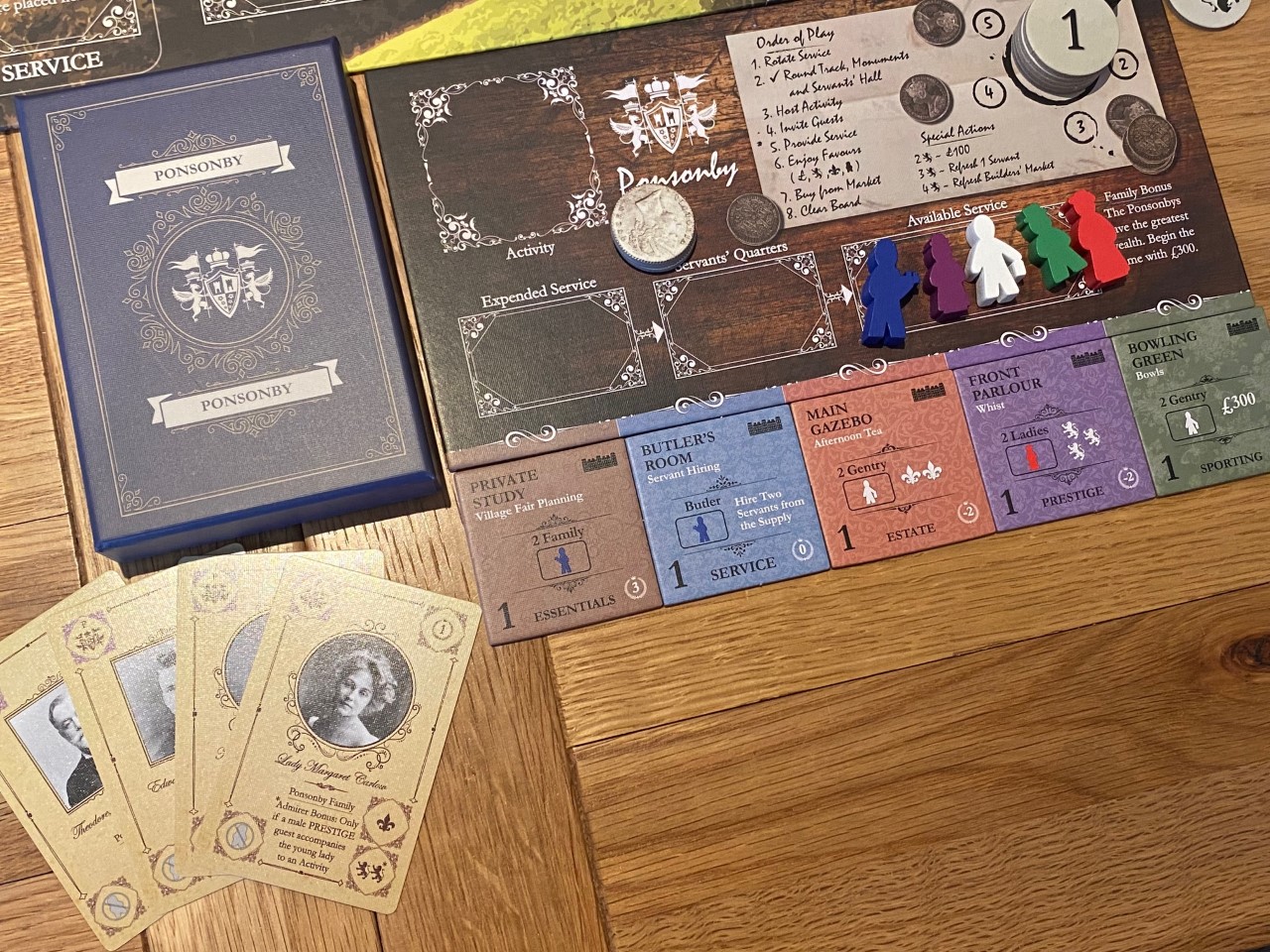
So with that said, let’s jump in. Obsession is a hybrid deck, engine and tableau building game with a little bit of what amounts to set collection thrown in. Ultimately, the players are targeting victory points, and with several visible (or semi-visible) VP sources, hidden objective cards and secret VP score cards, the focus is mostly on making the most of your own situation, rather than targeting others — although take that elements do exist within Obsession.
Each player begins by choosing a family and setting up their own country estate. In this version of Obsession, each family receives its own box (to hold their components) as well as a double-sided player board and an optional estate organiser. The only difference between the families is a single starting benefit — for example the Asquith’s begin with an additional family member, whilst Wessex has access to a choice of two additional starting improvements.
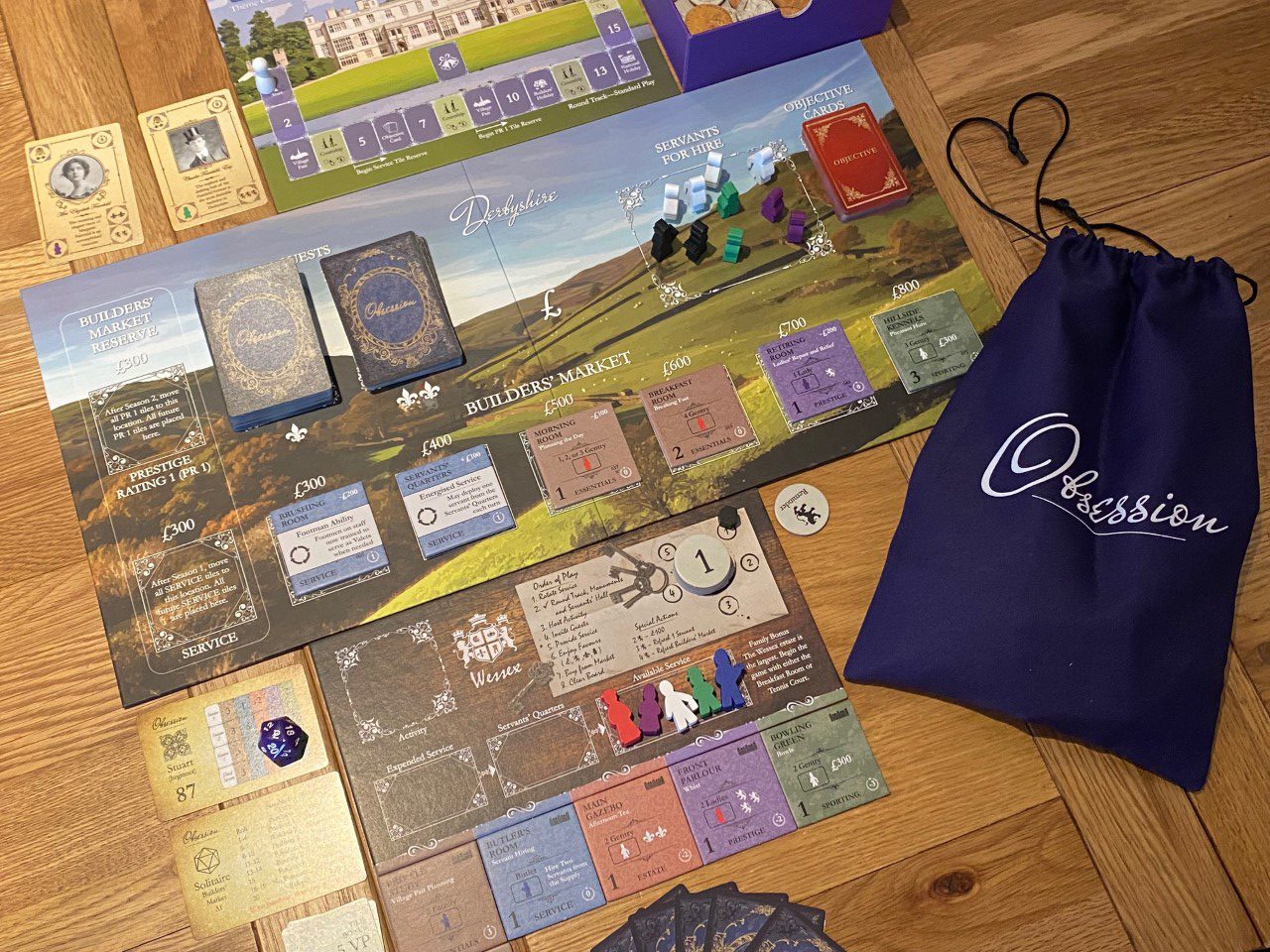
The rest of the setup is a relatively simple affair involving just placing a round tracker, dealing starting objective cards, sorting a market, building a couple of decks and sharing out some starting guest cards. There are some variants, including one that relates to the “Courtship” aspect of the game, and involves having the courtship objective (which is scored every four rounds) either visible to the players or hidden – and my firm preference is for the “open” variant so I just wanted to call that out now.
So far, this is all pretty standard, and as I started to play Obsession by myself in order to learn it, I felt that it was remarkably simple. The turn structure features about eight steps, but the reality is that most of these are related to upkeep or housekeeping, rather than action. The first step simply involves rotating any servants that were used in prior rounds one step closer to being available (there are two phases for exhausted servants to go through before they can be used again.) The second simply asks the player to observe any effects as indicated by their improvement tiles or on the main board itself.
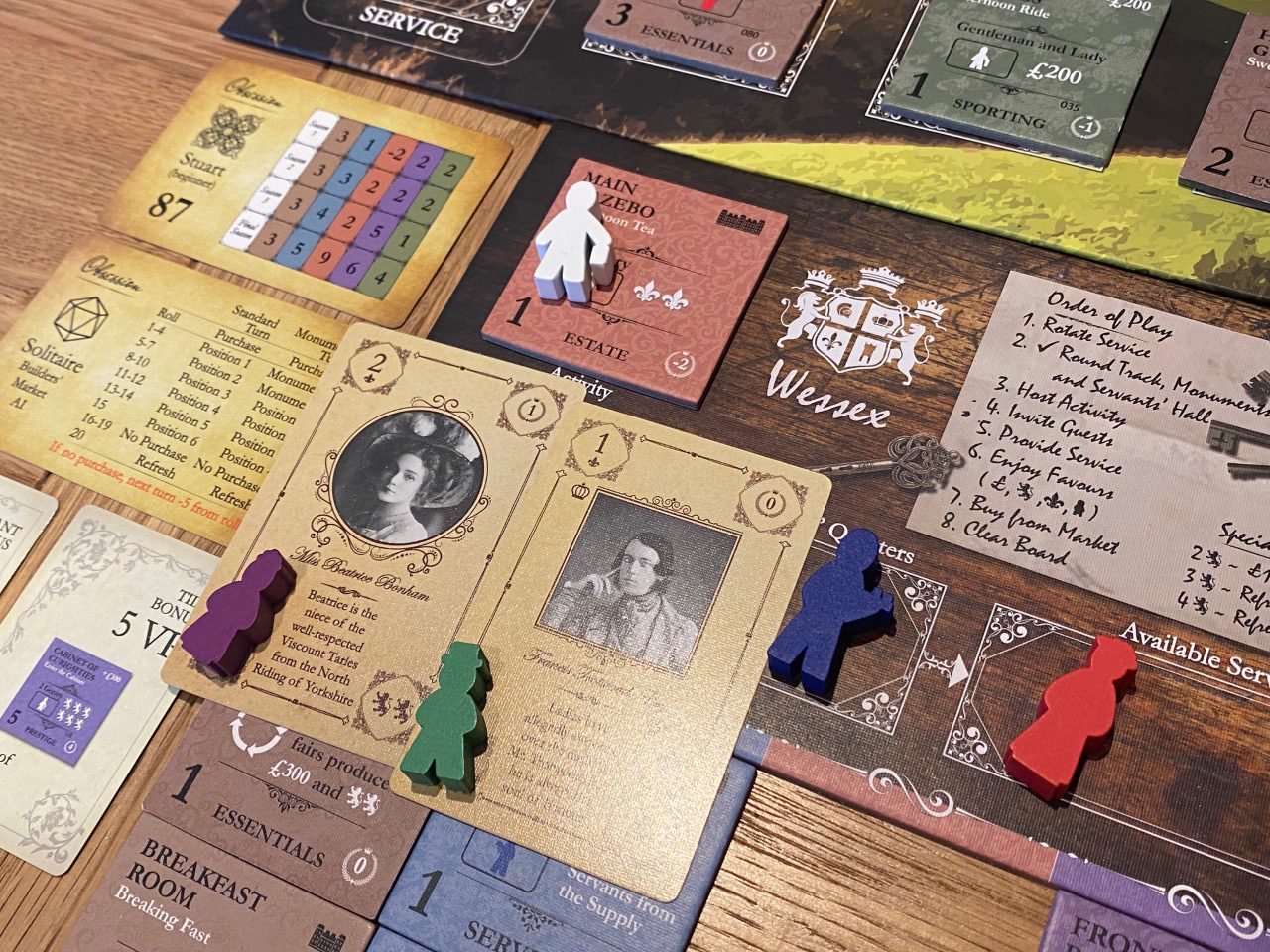
The third step is where the action really begins. At this point the player will choose one of the tiles (improvements as I keep calling them) from their estate and choose to “Host” that “Activity.” For example, this might be playing Whist in the front parlour, or it might be a private discussion between family members in the study. Whatever is chosen will have restrictions — a minimum reputation level being one, and the other being the kind of people (ladies, gentlemen, family, or anyone) who can attend.
Based on these restrictions (and bearing in mind you cannot host an activity that has a higher reputation requirement than your family standing) you will choose guests from your hand (represented by cards) and play them. In the examples above, Whist requires any two ladies (family or otherwise) whilst the private meeting is for any two family members. Other examples of higher reputation activities might be music recitals or sporting events that require perhaps six or more guests.
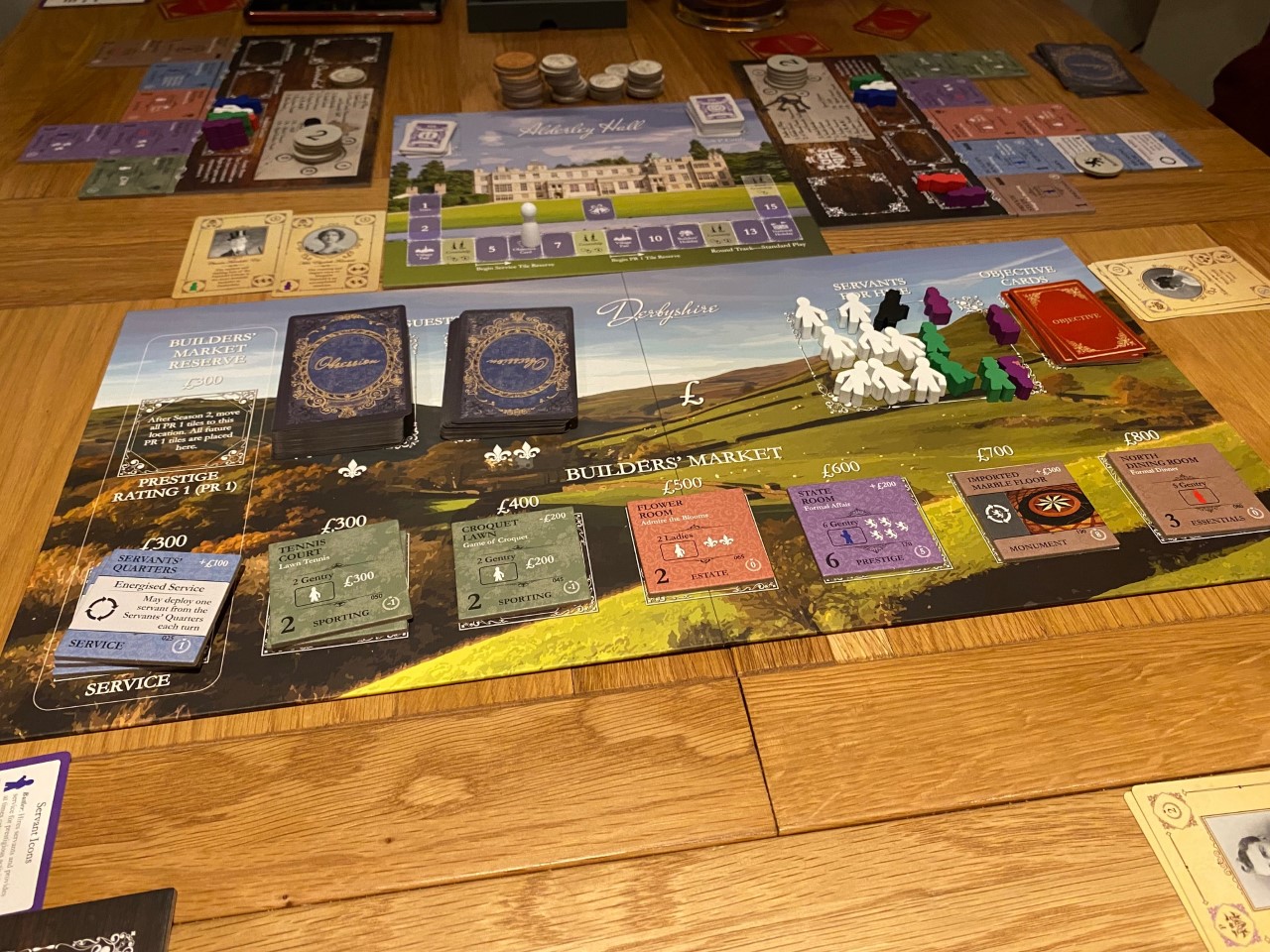
With the activity hosted and the guests invited, the player will provide service. This simply means that a servant must be placed on each servant symbol shown on the activity itself, and each guest card (if present). In general, the more reputable and valuable the guest, the more servants they will require, and if you cannot provide the required service, you will not be able to host an event or invite that guest, There is an alternative to the hosting action which is to pass, and in short that allows a player to refresh all their servants immediately, retrieve all their guest/family cards and usually to take a modest amount of money.
Now assuming that you did host an activity and choose some guests, and that you were able to serve them, you will now “receive the favours” associated with doing so. This is done by checking all symbols and effects on the activity and the guests and taking them in order of money, reputation gain, and then access to additional guests (either casual or prestige), which is indicated by either one or two fleur de lis symbols. New guests taken this way are added to your hand, but unless an effect allows you to draw X and take Y, you’ll always keep what you draw — which can be bad if you pick up cards which have negative victory points, or perhaps even those who are too high reputation to play.

After this is all done, the player will have the option to buy an improvement from a face up, public market, and if they do so they will pay for it and add the improvement to their tableau with it’s starting side up. Why do I mention a starting side, well now the activity that was just hosted will return to the tableau, and if it was starting side up, it will be flipped to its rear side — which will usually be worth more points, and may or may not have a slightly different effect when played again. Any expended servants are placed in the first resting area, whilst guests are placed in a personal discard to be redrawn when a pass turn happens.
Each player follows this same series of actions on their turn, with a game round consisting of each player doing this flow once. Every fourth round (as I mentioned earlier) there is a Courtship Round, which simply involves drawing (or looking at, if the open variant is used) the current courtship card, and whoever scores most in that area of their improvement tiles will take a hidden VP card and gains access to a powerful Fairchild heir or heiress card until the next courtship is resolved.

I should take a moment to discuss the thematic elements of courtship here, because they are a big part of Obsession’s game narrative. Wooing the Fairchild’s is intended to demonstrate the rising influence of your family, and as a consequence the chosen Fairchild (one male, one female) will join you as a guest for the next round — allowing them to be played/hosted as a powerful guest without a reputation limit or too many servant demands. If you hold a Fairchild card after the final courtship, it will be worth eight points instead.
What I find most interesting about how Obsession plays is the juxtaposition between the clean, simple components and structure, balanced against what is actually an intense amount of thought, and a lot of small complexities to manage. I don’t mean that latter point in a bad way, where some games frustrate with minor rules minutiae, I more mean that players will frequently – near constantly – be aware of how fragile their economic, reputation and staffing levels are, whilst also wanting to execute a grand plan.
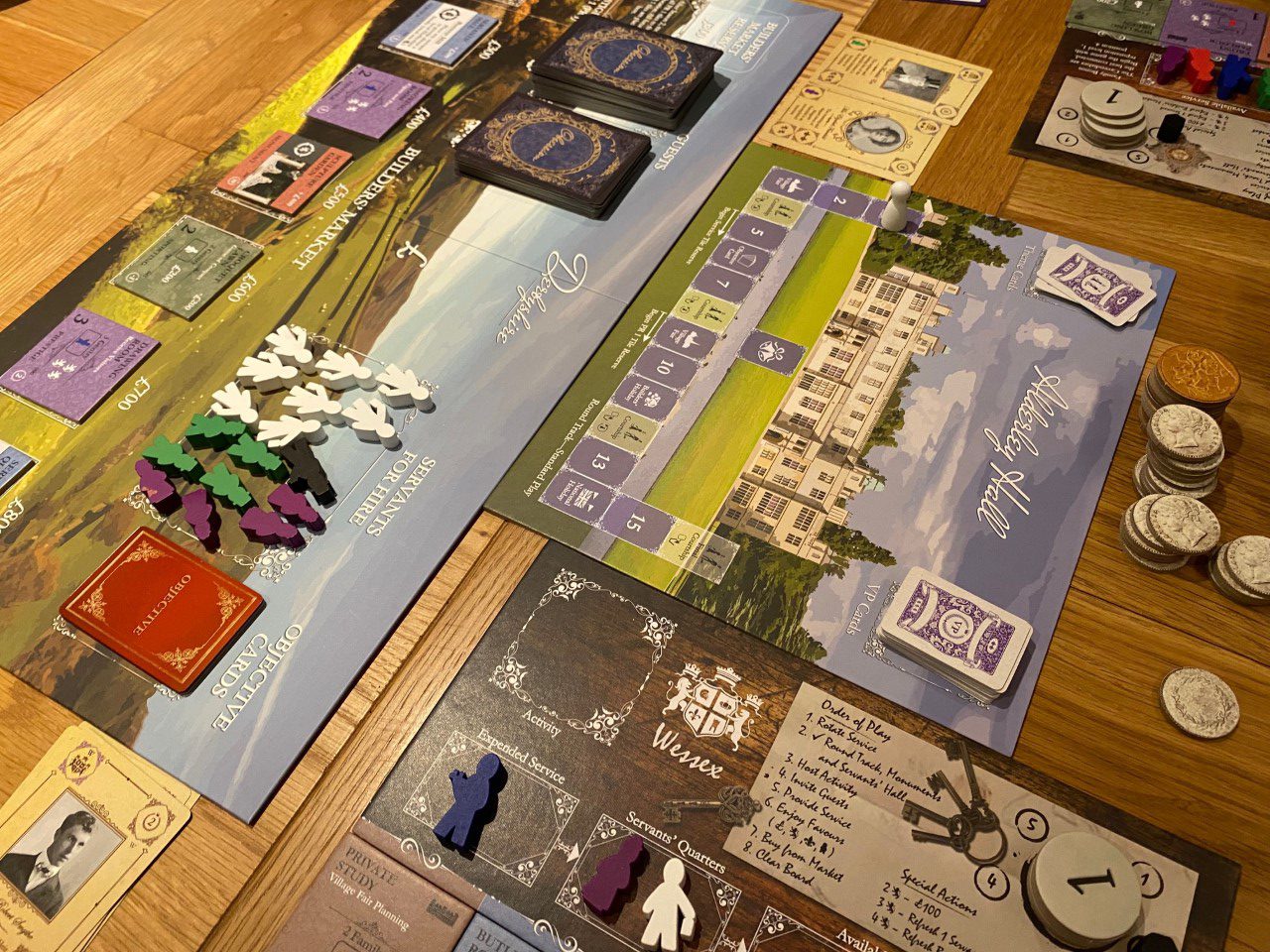
The way this feels is that each turn in Obsession must be very carefully planned. You will rarely have the exact situation that you want, and turns often become optimisation puzzles. For example, only perhaps once every game will you be able to host your most valuable event, inviting your best possible guests and then make the purchase you want to afterwards — in fact this almost never happens. It’s more likely that you’ll have to prioritise the hosting (and the favours you need from it) or the building (which might set you up for a later turn).
This can lend Obsession a slight multiplayer solitaire feel. There’s no doubt that players are very focussed on their own board, and whilst I could think of ways to play simultaneously to an extent, there is a bit of downtime as players move through the steps. There are some interactive elements – such as the way players can influence the builders market (or even refresh it, removing all tiles) however it’s a stretch to imagine the average player being able to keep track of both their board and those of other players well enough to use this to their advantage. Some cards and tiles also allow “gossip” which can basically allow small reputation swings, and has a nice thematic aspect to it.

Given that we are discussing the very slight downsides to Obsession, I also wanted to mention that there is a bit of unwelcome randomness in a game that is otherwise so tight and controllable. That comes in the form of the guest cards, which are almost always drawn randomly, with little option but to take what you have. Now, the caveats here are that some cards do allow a choice and each family has a matriarch who can “evict” unwelcome guests, but nonetheless, randomness is a thing.
I recall in one game, my neighbour drew a turn one “American Heiress” who generates £800 (an awful lot) but costs three reputation to play and minus two endgame points if kept, whilst I drew a Cad, who costs money to play, offers effectively nothing and costs points at the end if kept. The contrast here is that if you play the heiress two or three times early, she can’t reduce your reputation any further but you get very rich, meanwhile the Cad really just fills your hand.

I think these potentially highly variable draws could be mitigated with additional card selection or removal mechanisms (and maybe they are with further expansions), but my sense of this in the base game is that each turn is too valuable to want to build around getting rid of guests, whilst as I mentioned above, an early American Heiress (especially the very best one) can unbalance the game quite significantly.
Even despite these relatively minor issues considered, Obsession is a very enjoyable, massively thematic experience that seems to be capable of bringing together players who have a lot of experience with those who don’t play games. I played several games with my wife and her friends who all fastidiously followed the excellent player aids and narrated their turns, ultimately to the point where they seemed to be really enjoying the experience.
When I played with others who were perhaps a bit more used to games of this weight, the dynamic changed slightly to be one of absolute efficiency, but the theme links so well with the mechanics that it still shines through. Overall, despite a few wrinkles which I’ve already mentioned, Obsession has quickly become a favourite around here, and I can’t wait to explore some of the more advanced expansion content to see what it brings. The bottom line is that Obsession is one of those rare games that really does live up to the hype.
Unfortunately Obsession is very hard to find in stock, so I’d use BoardGamePrices as a good starting point.
Love board games? Check out our list of the top board games we’ve reviewed.
Comments are closed.